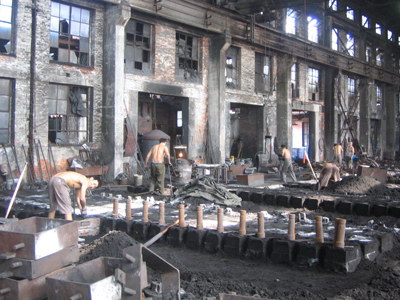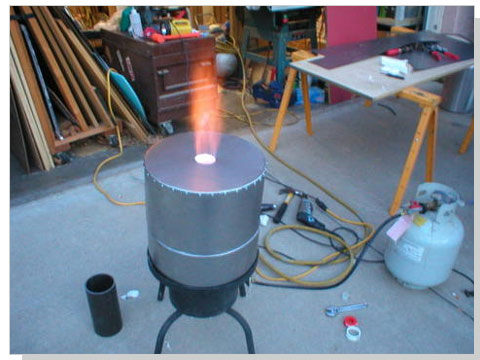Inside look at the innovative processes inside a Metal Foundry
Discover the Ingenious Techniques Utilized in a Metal Foundry for Superior Casting Outcomes
In today's affordable manufacturing landscape, metal foundries are significantly adopting cutting-edge methods to enhance casting results - Aluminum Casting. Advanced computer system simulations permit accurate modeling of liquified metal actions, while 3D printing allows fast production of complex mold and mildews. Additionally, environmentally friendly materials and automation enhance operations. These growths assure considerable renovations in performance and top quality control. However, the effect of these innovations on sustainability and manufacturing practices remains to be fully explored
Advanced Computer Simulations in Metal Casting
Advanced computer simulations have reinvented the metal spreading process by boosting precision and effectiveness. These innovative devices permit engineers to develop online versions of cast elements, allowing them to evaluate and forecast the behavior of molten metal during the spreading stage. By replicating various parameters such as temperature, flow rate, and air conditioning rates, producers can determine prospective issues prior to physical manufacturing begins.
This positive technique minimizes waste and reduces pricey errors, inevitably bring about boosted item top quality. Additionally, simulations assist in the optimization of mold and mildew styles, guaranteeing that they meet the certain needs of each job. The integration of computational fluid dynamics (CFD) and finite component analysis (FEA) additional adds to the precision of these simulations, giving understandings that were previously unattainable. Therefore, advanced computer system simulations have actually become a crucial component of modern-day metal foundries, greatly progressing the market's capacities.
3D Printing for Mold And Mildews and Patterns
3D printing has emerged as a groundbreaking technique for creating mold and mildews and patterns in the metal foundry market. This technology enables the fast manufacturing of intricate geometries that traditional manufacturing approaches battle to achieve. By utilizing additive manufacturing, foundries can develop complex layouts with lowered lead times and material waste. The ability to produce molds as needed allows for better adaptability in design models, facilitating faster prototyping and alterations.
3D printing can make use of a selection of materials, including plastics and metals, tailored to specific casting demands. This flexibility boosts the accuracy of mold and mildews, causing remarkable casting outcomes with improved surface coatings. Additionally, the decrease in the number of components called for simplifies assembly procedures, further optimizing production effectiveness. As foundries remain to adopt 3D printing, they are positioned to redefine market criteria, paving the method for advancement and enhanced performance in metal casting operations.
Eco-Friendly Materials and Processes
As the metal foundry market faces enhancing pressure to minimize its ecological impact, the fostering of eco-friendly products and processes has come to be necessary. Foundries are now exploring lasting choices to typical products, such as utilizing bio-based binders and recycled steels. These products not just reduce waste however additionally lower energy consumption during manufacturing.
Furthermore, developments in sand casting techniques have led to using synthetic sands that are much less dangerous to the setting. Factories are also implementing ingenious procedures like liquified metal therapy that pop over to these guys lowers emissions and boosts the quality of cast products.
In addition, water-based coatings have actually changed hazardous solvents, advertising a safer workplace (Aluminum Foundry). By integrating these environment-friendly techniques, metal foundries can significantly lower their ecological influence while keeping high-quality casting outcomes. This change not only profits the atmosphere however additionally aligns with the growing customer need for lasting manufacturing options
Automation and Robotics in Foundry Procedures
While the metal foundry industry accepts technology, the assimilation of automation and robotics is transforming operations considerably. Automated systems enhance processes such as mold production, metal putting, and casting completing, substantially improving efficiency. Robotics facilitate the handling of hefty materials, minimizing the threat of workplace injuries and making sure more secure atmospheres.

Better, using automated assisted vehicles (AGVs) optimizes material transportation within centers, making sure prompt shipment of components to appropriate workstations. By applying these innovations, foundries can adjust to rising and fall needs with better dexterity, eventually causing improved success and competition out there. As automation and robotics remain to develop, they hold the possible to redefine traditional foundry practices and drive more innovations in casting techniques.
Real-Time Monitoring and High Quality Control Techniques
The innovations in automation and robotics have led the method click site for much more sophisticated methods to quality guarantee in metal foundries. Real-time monitoring systems utilize advanced sensors and information analytics to track important criteria throughout the spreading process. These systems continually analyze variables such as stress, product, and temperature composition, enabling prompt detection of discrepancies from established criteria.
Quality control strategies now include maker learning formulas that analyze historical information to anticipate possible issues prior to they happen. This positive method lessens waste and boosts general manufacturing efficiency. Furthermore, integrated comments loops enable for rapid changes, click for more guaranteeing that each casting meets stringent high quality needs.
The execution of electronic twins-- digital replicas of physical possessions-- has additionally transformed high quality assurance, permitting designers to replicate and optimize procedures in real-time. Together, these innovative techniques greatly boost the reliability and quality of castings, setting new industry standards in metal foundry procedures.
Often Asked Questions
What Sorts of Metals Are Typically Cast in Shops?
Generally cast steels in foundries consist of light weight aluminum, bronze, iron, and brass. Each metal shows special homes, making them suitable for various applications, such as automobile parts, machinery, and creative sculptures, enhancing their flexibility in production.

For how long Does the Casting Refine Normally Take?
The casting procedure commonly takes a number of hours to days, relying on factors such as the intricacy of the mold, kind of metal utilized, and cooling needs. Each stage affects the general duration substantially.
What Safety and security Measures Are in Place for Foundry Workers?

Exactly how Are Issues in Castings Identified and Addressed?
Defects in spreadings are recognized via visual examinations and non-destructive testing approaches. Once spotted, foundry workers address them by fine-tuning processes, adjusting product make-ups, and implementing corrective steps to assure high quality and conformity with requirements.
What Is the Cost Array for Metal Casting Solutions?
The price range for metal casting solutions usually varies between $1 to $10 per pound, depending upon aspects such as material kind, complexity of the style, and production volume, affecting total pricing considerably.
In today's competitive production landscape, metal foundries are significantly embracing innovative methods to enhance casting outcomes. As the metal foundry market faces raising stress to lower its environmental footprint, the fostering of green products and processes has become vital. Foundries are currently exploring sustainable options to traditional materials, such as making use of bio-based binders and recycled steels. By incorporating these environment-friendly methods, metal foundries can noticeably lower their environmental influence while keeping top notch spreading outcomes. The developments in automation and robotics have actually led the method for a lot more advanced methods to quality guarantee in metal foundries.